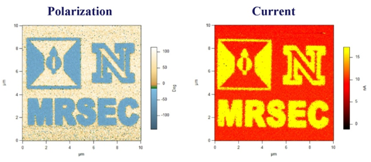 Ferroelectric materials have been the subject of intense development for use in nonvolatile memories, where bits of information are stored as polarization dipoles oriented up and down. The most serious problem related to a traditional charge-based approach to such ferroelectric memories is leakage currents that lead to a large power consumption and progressive loss of stored information. The discovery of MRSEC researchers at University of Nebraska-Lincoln in collaboration with their colleagues turns this problem into an advantage. The researchers have demonstrated a change in tunneling resistance of ultra-thin ferroelectric films of BaTiO3 by several orders of magnitude upon switching the ferroelectric polarization (Nano Letters 9, 3539 (2009)). Since measuring the electrical resistance allows a nondestructive read-out of the polarization state at a significantly lower voltage, this discovery may lead to significantly reduced power consumption of nanoelectronic devices based on tunneling conductance of ultra-thin ferroelectrics. Application of advanced measurements techniques showed that a single bit of information could be as small as 20 nanometers in diameter (1/1000th diameter of a human hair). This discovery followed theoretical predictions made earlier by Nebraska MRSEC researchers (Phys. Rev. Lett. 94, 246802 (2005)) and could revolutionize the field of nanoelectronics by allowing faster, smaller and more energy-efficient memory devices.
Ferroelectric materials have been the subject of intense development for use in nonvolatile memories, where bits of information are stored as polarization dipoles oriented up and down. The most serious problem related to a traditional charge-based approach to such ferroelectric memories is leakage currents that lead to a large power consumption and progressive loss of stored information. The discovery of MRSEC researchers at University of Nebraska-Lincoln in collaboration with their colleagues turns this problem into an advantage. The researchers have demonstrated a change in tunneling resistance of ultra-thin ferroelectric films of BaTiO3 by several orders of magnitude upon switching the ferroelectric polarization (Nano Letters 9, 3539 (2009)). Since measuring the electrical resistance allows a nondestructive read-out of the polarization state at a significantly lower voltage, this discovery may lead to significantly reduced power consumption of nanoelectronic devices based on tunneling conductance of ultra-thin ferroelectrics. Application of advanced measurements techniques showed that a single bit of information could be as small as 20 nanometers in diameter (1/1000th diameter of a human hair). This discovery followed theoretical predictions made earlier by Nebraska MRSEC researchers (Phys. Rev. Lett. 94, 246802 (2005)) and could revolutionize the field of nanoelectronics by allowing faster, smaller and more energy-efficient memory devices.
Image: Ferroelectric polarization pattern of a thin ferroelectric film in the form of the MRSEC logotip and the same pattern imaged by detecting local tunneling current across the film.